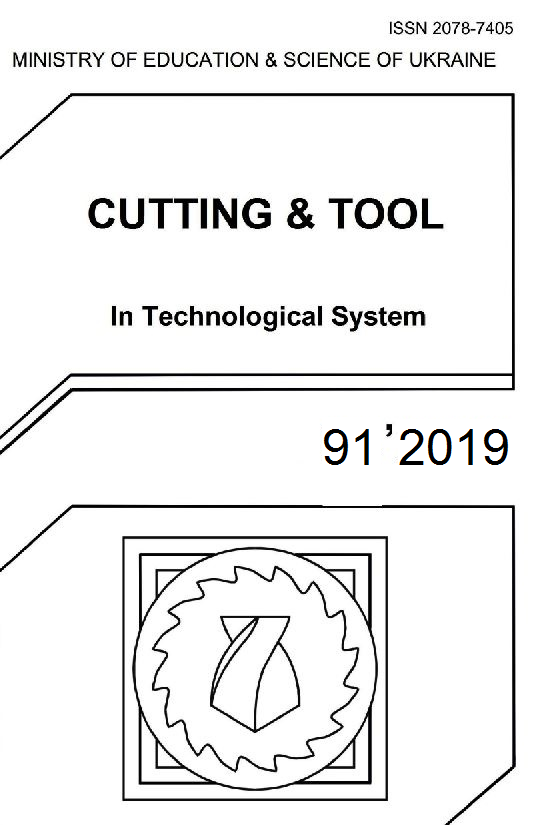THE METHODOLOGY OF SHARPENING OF BLADE TOOLS MADE OF SUPERHARD MATERIALS
DOI:
https://doi.org/10.20998/2078-7405.2019.91.17Keywords:
blade tool from SHM, defects in the internal structure, sharpening and finishing, tool reliability, extreme operating conditions, stress-strain state, diamond grain, grinding conditions.Abstract
High durability of the blade tool from superhard materials (SНM), which have unique physical and mechanical properties, creates the prerequisites for its effective use in automated production. However, the widespread use of such tools is constrained by its relatively low reliability during operation. This disadvantage is due to the imperfection of the processes of obtaining SНM: the presence in it residual stresses, internal defects, which appear even after sharpening and thermo-activated finishing. The processes of sharpening of tool blade from superhard materials and cutting with this tool are characterized by high levels of contact pressures and temperatures in the treatment area. Therefore, it seems inappropriate to choose sparing conditions for its sharpening and refinement to ensure the defect of these processes. In connection with this, a new methodological approach is proposed, which makes it possible to determine the cutting conditions and other conditions for sharpening and finishing the SНM blade tool, in which material defects are revealed even at the tool manufacturing stage. To this end, in the software packages COSMOS, ANSYS, NOSTRAN, Third Wave AdvantEdge, thermo-force stress in the cutting edge of the tool simulated under extreme conditions while its operation. This simulations are the initial data for solving the inverse problem – finding conditions (speed, cross feed, normal pressure in the contact) and other diamond grinding modes (physical and mechanical properties of the bond and diamond grains of the wheel, grain size and concentration) according to the well-known stress-strain state cutter from SНM in extreme conditions of its operation. The proposed methodology allows rejecting defective cutters at the stage of their manufacture, thereby increasing the reliability of operation of blade tool from superhard materials.References
Shuljenko A. A. Polikristallicheskie sverhtverdyie materialyi v rejuschem instrumente // Іnstrumentalniy svіt. – 1999. – № 4-5. – pp. 14–16, № 6. – pp. 10–12.
Devin L. N., Stahniv N. E. Primenenie metoda akusticheskoy emissi dlya otsenki rabotosposobnosti reztsov iz ATP pri tochenii alyuminievyih splavov // Rezanie i instrument v tehnologicheskih sistemah. – Vyip. 62. – 2002. – pp. 44–47.
Romanov V. F. Spetsialnyie instrumentyi iz polikristallicheskih almazov (PCD), kubicheskogo nitrida bora (PCBN) i keramiki dlya vyisokoskorostnogo rezaniya detaley iz chernyih i tsvetnyih metallov // Rezanie i instrument v tehnologicheskih sistemah. – 2002. – Vyip. 63. – pp. 139–144.
Novikov N. V., Devin L. N. Nadejnost lezviynyih instrumentov iz PSTM pri chistovom tochenii zakalennyih staley // Sb. nauch. tr. Instituta sverhtverdyih materialov im. V. N. Bakulya NAN Ukrainyi. Seriya G: Protsessyi mehanicheskoy obrabotki, stanki i instrumentyi. – Kyiv, 2002. – pp. 273–280.
Novikov N. V., Devin L. N. Nadejnost lezviynyih instrumentov iz PSTM pri chistovom tochenii trudnoobrabatyivaemyih materialov // Materialyi X Mejdunar. nauch.-tehn. seminara «Vyisokie tehnologii: razvitie i kadrovoe obespechenie», Kharkiv, 2000. – pp. 98–100.
Fedorovich V. A., Kozakova N. V. Opredelenie rejimov i usloviy zatochki lezviynogo instrumenta iz sverhtverdyih materialov v zavisimosti ot ego ekspluatatsionnogo naznacheniya // Rezanie i instrument v tehnologicheskih sistemah. – 2004. – Vyip. 66. – pp. 203–208.
Huang J. M. An Evaluation of Chip Separation Criteria for the FEM Simulation of Machining / J. M. Huang, J. T. Black // Journal of Manufacturing Science and Engineering: Trans. of ASME. – 1996. – Vol. 118, No 4. – pp. 545–554.
Zaghbani I. A thermo-mechanical coupled f.e.m model for orthogonal cutting / I. Zaghbani, W. Bouzud, K. SaI // Proceedings of the 8th CIRP International Workshop on Modeling of Machining Operations. – 2005. – pp. 139–145.
Markopoulos A. P., Kundrák J. FEM/AI models for the simulation of precision grinding, Manufacturing Technology, 16(2), pp. 384–390. (2016).
Mamalis A. G., Kundrák J., Manolakos D. E., Gyáni K., Markopoulos A. Thermal Modelling of Surface Grinding Using Implicit Finite Element Techniques // International Journal of Advanced Manufacturing Technology, 21(12), pp. 929–934. (2003).
Downloads
Published
Issue
Section
License
Copyright Notice
Authors who publish with this Collection agree to the following terms:
1. Authors retain copyright and grant the Collection right of first publication with the work simultaneously licensed under a Creative Commons Attribution License that allows others to share the work with an acknowledgement of the work's authorship and initial publication in this Collection.
2. Authors are able to enter into separate, additional contractual arrangements for the non-exclusive distribution of the Collection's published version of the work (e.g., post it to an institutional repository or publish it in a book), with an acknowledgement of its initial publication in this Collection.
3. Authors are permitted and encouraged to post their work online (e.g., in institutional repositories or on their website) prior to and during the submission process, as it can lead to productive exchanges, as well as earlier and greater citation of published work.

